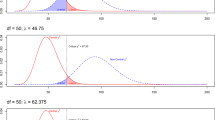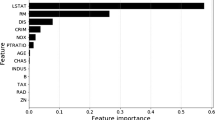Abstract
Rivest and Wells (2001) proposed estimators of the marginal survival functions in a right-censored model that assumes an Archimedean copula between the survival time and the censoring time. We study the extension of these estimators to the context of right-censored semi-competing risks data with an independent second level censoring time. We intensively use martingale techniques to derive their large sample properties under mild assumptions on the true distribution of the data. As compared to the simpler context of right-censored data, a primary difference is the need to enlarge the filtrations with respect to which we use the Doob-Meyer decompositions of counting processes.
Similar content being viewed by others
References
Aalen, O.O., Andersen, P.K., Borgan, Ø., Gill, R.D. and Keiding, N. (2009). History of applications of martingales in survival analysis. Electron. J. Hist. Probab. Stat., 5, 1–28. http://arxiv.org/abs/1003.0188.
Andersen, P.K., Borgan, Ø., Gill, R.D. and Keiding, N. (1993). Statistical models based on counting processes. Springer, New York.
Billingsley, P. (1999). Convergence of probability measures. Second edition. Wiley.
Bielecki, T.R., Jeanblanc, M. and Rutkowski, M. (2008). Ann. Appl. Probab., 18, 2495–2529.
Braekers, R. and Veraverbeke, N. (2005). A copula-graphic estimator for the conditional survival function under dependent censoring. Canad. J. Statist., 33, 429–447.
Chen, Y.-H. (2012). Maximum likelihood analysis of semicompeting risks data with semiparametric regression models. Lifetime Data Anal., 18, 36–57.
Chen, X., Linton, O. and Van Keilegom, I. (2003). Estimation of semiparametric models when the criterion function is not smooth. Econometrica, 71, 1591–1608.
Émery, M. and Schachermayer, W. (2001). On Vershik’s standardness criterion and Tsirelson’s notion of cosiness. Séminaire de Probabilités XXXV. Springer Lectures Notes in Math. 1755, Berlin 2001, pp. 265–305.
Ethier, S.N. and Kurtz, T.G. (1986). Markov processes: Characterization and convergence. John Wiley & Sons, New York, Chichester, Brisbane, Toronto, and Singapore.
Fine, J.P., Jiang, H. and Chappell, R. (2001). On semicompeting risks. Biometrika, 88, 907–919.
Fleming, T.R. and Harrington, D.P. (1991). Counting processes and survival analysis. Wiley, New York.
Gapeev, P.V. and Jeanblanc, M. (2008). On Filtration Immersions and Credit Events. CDAM Research Report Series, LSE-CDAM-2008-24.
Heuchenne, C., Laurent, S., Legrand, C. and Van Keilegom, I. (2011). Likelihood based inference for semi-competing risks. Discussion paper DP2011/22 of the Institute of Statistics. To appear in: Communications in Statistics - Simulations and Computations.
Jacobsen, M. (1982). Statistical analysis of counting processes. Lecture Notes in Statistics, Vol. 12, Springer-Verlag, New York.
Jacobsen, M. (1989). Right censoring and Martingale methods for failure time data. Ann. Statist., 17, 1133–1156.
Jacod, J. and Shiryaev, A.N. (2003). Limit Theorems for Stochastic Processes. Second edition. Springer.
Jiang, H., Fine, J.P., Kosorok, R. and Chappell, R. (2005). Pseudo self-consistent estimation of a copula model with informative censoring. Scand. J. Stat., 33, 1–20.
Kallenberg, O. (1997). Foundations of modern probability. Springer, Berlin Heidelberg New York.
Karatzas, I. and Shreve, S. (1988). Brownian motion and stochastic calculus. Springer Verlag, New York.
Lakhal, L., Rivest, L-P. and Abdous, B. (2008). Estimating survival and association in a semicompeting risks model. Biometrics, 64, 180–188.
Li, Y., Tiwari, R.C. and Guha, S. (2007). Mixture cure survival models with dependent censoring. J. R. Stat. Soc. B, 69, 285–306.
Mansuy, R. and Yor, M. (2006). Random times and enlargements of filtrations in a Brownian setting. Lecture Notes in Mathematics 1873, Springer.
Nelsen, R.B. (1999). An introduction to copulas. Springer-Verlag, New York.
Prigent, J.-L. (2003). Weak convergence of financial markets. Springer.
Rivest, L. and Wells, M.T. (2001). A martingale approach to the copula-graphic estimator for the survival function under dependent censoring. J. Multivariate Anal., 79, 138–155.
van der Vaart, A.W. and Wellner, J.A. (1996). Weak convergence and empirical processes. Springer-Verlag, New York.
Xu, J., Kalbfleisch, J.-D. and Tai, B. (2010). Statistical analysis of illness-death processes and semicompeting risks data. Biometrics, 66, 716–725.
Author information
Authors and Affiliations
Corresponding author
A Delta method in the Skorohod space
A Delta method in the Skorohod space
The goal of this appendix is to prove a version of the Delta method in the Skorohod space D[0,1] when the limit process is continuous, because we do not find it in the literature. The proof we give is essentially the same as the proof of the Delta method for real random variables. An alternative proof consists in using the powerful functional Delta method (van der Vaart and Wellner, 1996) after having said that in this context, the weak convergence in D[0,1] is equivalent to the weak convergence in the uniform sense, as in the modern theory of empirical processes; this fact results from theorem 1.7.2 in van der Vaart and Wellner (1996) and theorem 6.6 in Billingsley (1999). All our statements are proved for stochastic processes in the Skorohod space \(D\bigl([0,1], {\mathbb{R}}^d\bigr)\) which we shortly denote by D[0,1]. Similarly we shortly denote by C[0,1] the space of continuous functions \(C\bigl([0,1], {\mathbb{R}}^d\bigr)\)
Lemma A.1
Let (X n ) be a sequence of random variables in D[0,1] which converges weakly to a random variable X in C[0,1]. Then the sequence \(\bigl(\sup_{0 \leq s \leq 1}\Vert X_n(s)\Vert\bigr)\) converges weakly to \(\sup_{0 \leq s \leq 1}{\Vert X(s)\Vert}\) .
Proof
This follows from the continuity of \(x \mapsto \sup_{0 \leq s \leq 1}\Vert x(s)\Vert\) outside a set with null measure with respect to the law of X.
Lemma A.2
Let (Z n ) be a sequence of random variables in D[0,1] such that \(\sup_{0 \leq t \leq 1}\bigl\Vert Z_n(t) \bigr\Vert = o_P(1)\) and the sequence \((\sqrt{n}Z_n)\) converges weakly to a random variable W in C[0,1]. Let \(R \colon {\mathbb{R}}^d \to {\mathbb{R}}\) be a function such that \(R(z)=o\bigl(\Vert z\Vert \bigr)\) when z→0. Then \(\sup_{0 \leq t \leq 1}\left|\sqrt{n}R\bigl(Z_n(t)\bigr)\right| =o_P(1)\) .
Proof
One has
where h is the function defined by \(h(z)=\left|R(z)\right|/\Vert z\Vert\) if z ≠ 0 and h(0) = 0, which is continuous at 0. The sequence \(\bigl(\sup_{0 \leq s \leq 1}\Vert \sqrt{n}Z_n(s)\Vert\bigr)\) converges weakly to \(\sup_{0 \leq s \leq 1}\Vert W(s)\Vert\) by Lemma A.1, hence, owing to Slutsky’s theorem, it suffices to show that \(\sup_{0 \leq t \leq 1} h\bigl(Z_n(t)\bigr)=o_P(1)\), but this follows from the continuity of h at 0.
Proposition A.1
(Delta method) Let (X n ) be a sequence of random variables in D[0,1] and θ a function belonging to D[0,1]. Assume that \(\sup_{0 \leq t \leq 1}\bigl\Vert X_n(t)-\theta(t) \bigr\Vert = o_P(1)\) and that the sequence \(\sqrt{n}\bigl(X_n-\theta\bigr)\) converges weakly in D[0,1] to a random variable G in C[0,1]. Let \(g\colon {\mathbb{R}}^d \to {\mathbb{R}}^k\) be a differentiable function. Denote by R μ the remainder in the first order Taylor expansion of g at μ , that is, R μ (y) = g(μ + y) − g(μ) − g′(μ)(y). If \(\sup_{0 \leq t \leq 1}\bigl\Vert R_{\theta(t)}(y) \bigr\Vert=o\bigl(\Vert y\Vert\bigr)\) , then \(\sqrt{n}\bigl(g(X_n)-g(\theta)\bigr) = g'(\theta)\sqrt{n}\bigl(X_n-\theta\bigr) + o_P(1)\) uniformly on [0,1], therefore \(\sqrt{n}\bigl(g(X_n)-g(\theta)\bigr)\) converges weakly to g′(θ)G in D[0,1].
Proof
One has
where \(R(y) = \sup_{0 \leq t \leq 1} \bigl\Vert R_{\theta(t)}(y) \bigr\Vert\), hence the result follows from the preceding lemma.
Denoting by H the limiting process in the above proposition, its variance function is \({\mathbb{E}} H(s){H(t)}' = D_{\theta(s)} C(s,t) D'_{\theta(t)}\) where D z is the matrix of g′(z) and \(C(s,t) = {\mathbb{E}} G(s){G(t)}'\) is the variance function of G.
Rights and permissions
About this article
Cite this article
Laurent, S. Estimating the survival functions in a censored semi-competing risks model. Sankhya A 75, 231–252 (2013). https://doi.org/10.1007/s13171-013-0023-2
Received:
Revised:
Published:
Issue Date:
DOI: https://doi.org/10.1007/s13171-013-0023-2




